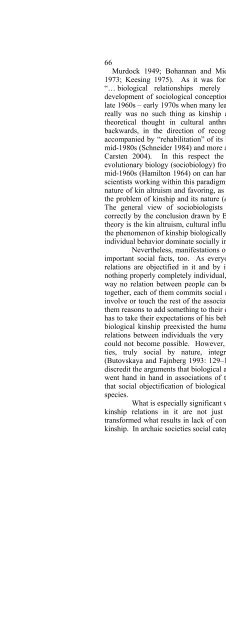Bondarenko Dmitri M. Homoarchy
Bondarenko Dmitri M. Homoarchy
Bondarenko Dmitri M. Homoarchy
You also want an ePaper? Increase the reach of your titles
YUMPU automatically turns print PDFs into web optimized ePapers that Google loves.
66<br />
Murdock 1949; Bohannan and Middleton 1968; Needham 1971; Goody<br />
1973; Keesing 1975). As it was formulated by Robert Lowie (1948: 57),<br />
“… biological relationships merely serve as a starting point for the<br />
development of sociological conceptions of kinship”. After the period of the<br />
late 1960s – early 1970s when many leading anthropologists declared that there<br />
really was no such thing as kinship at all (see Barnes 2006), the wave of<br />
theoretical thought in cultural anthropology seems to have been rolling<br />
backwards, in the direction of recognition of the phenomenon of kinship<br />
accompanied by “rehabilitation” of its biological background, slowly from the<br />
mid-1980s (Schneider 1984) and more and more rapidly nowadays (vide stricto<br />
Carsten 2004). In this respect the contribution to the theory made by<br />
evolutionary biology (sociobiology) from the first steps of the discipline in the<br />
mid-1960s (Hamilton 1964) on can hardly be overestimated. In particular, the<br />
scientists working within this paradigm have shown the primordially biological<br />
nature of kin altruism and favoring, as well as of many other events related to<br />
the problem of kinship and its nature (e.g., Chagnon and Irons 1979: 79–249).<br />
The general view of sociobiologists on this problem may be represented<br />
correctly by the conclusion drawn by Birgit Stцbich (2002: 51): “The stronger<br />
theory is the kin altruism, cultural influence cannot be that strong.” That is, in<br />
the phenomenon of kinship biologically (genetically) predetermined features of<br />
individual behavior dominate socially imposed norms.<br />
Nevertheless, manifestations of kin altruism, favoring and so forth are<br />
important social facts, too. As everyone lives in a society, all the personal<br />
relations are objectified in it and by it. Actually, in this sense in a society<br />
nothing properly completely individual, personal can ever be found. The same<br />
way no relation between people can be purely biological: when relatives live<br />
together, each of them commits social acts every moment – the acts that if not<br />
involve or touch the rest of the association members directly, in any case give<br />
them reasons to add something to their evaluation of that person while the latter<br />
has to take their expectations of his behavior into account. One might say that<br />
biological kinship preexisted the human society, as far as without biological<br />
relations between individuals the very appearance of Homo sapiens of course<br />
could not become possible. However, as it is stressed by sociobiologists, the<br />
ties, truly social by nature, integrate non-human primate associations<br />
(Butovskaya and Fajnberg 1993: 129–148), and hence there are no reasons to<br />
discredit the arguments that biological and social in the phenomenon of kinship<br />
went hand in hand in associations of the humans’ direct ancestors either and<br />
that social objectification of biological relations is also older than the human<br />
species.<br />
What is especially significant with respect to the human society, is that<br />
kinship relations in it are not just objectified but also categorized and<br />
transformed what results in lack of convergence between biological and social<br />
kinship. In archaic societies social categorization as such takes the shape of all-







